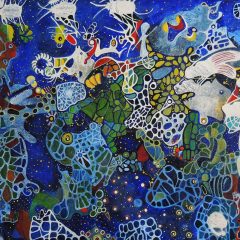I’m long overdue telling you about the rest of our trip to New York. See Libby’s post for first installment. Here’s my report on the shows by our town’s fabulous Judith Schaechter at Claire Oliver Fine Art and by German artist Neo Rauch at David Zwirner. Both shows are excellent, and luckily they’re both up for a while (Schaechter til June 11 and Rauch through June 18). So get on by and see them.
Through the glass darkly
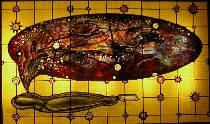
This is Schaechter’s second solo exhibit with the gallery. The stained glass artist, whose resume now includes the 2002 Whitney Biennial, a Pew fellowship and a 2005 Guggenheim fellowship, continues to turn the world of stained glass upside down making images of dark contemplation that turn the mind to the world of here and now instead of into some spiritual realm. (image is “Body Bag”)
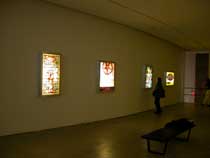
Schaechter’s works, some of which play with a grid of imagery instead of a central image framed with a border, as is her usual motif, show the artist experimenting with form although continuing her content about humans, animals, bees, bugs, and other creatures in stages of implied threat. The works vibrate with themes from today’s world even though their ambiance is retro, the damsels clothed in nighties and frocks right out of, what, the 20s perhaps? (image is installation shot of lightboxes in the dark gallery)
The big news is that out of the 11 new lightbox works all but one were sold when we were there.
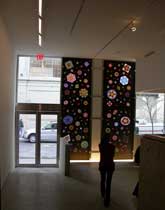
COFA’s new storefront gallery has a nice, open step-up space in the rear where the works glow in the dark. Like in church, there’s a bench to sit on and looking back over your shoulder you can see the artist’s window installation, a rosette-happy two-panel piece that pushes the religion/no-religion edge of the stained glass form. Schaechter’s rosettes evoke the world’s cathedrals but they don’t conjure a godhead. Rather what they conjure are baubles and jewels whose delights are sensual; what they conjure is Tiffanys and Cartiers and a pirate’s chest full of booty. Some of our party didn’t care much for them but I loved the big dark windows with their almost too rich ambiance. It’s either the Catholic in me enjoying a poke at those church windows — or it’s the kid in me. Bright, shiny, colorful, pretty? What’s not to love. (image is those rosettes)
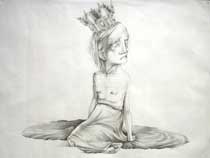
Schaechter had several delicate pencil drawings on view as well, like the one pictured here (“Deposed”).
There’s something langorous and almost narcoleptic about Schaecter’s ladies. Walking dreamers who are both vulnerable and formidable, they’re so completely engaged in their dream that you fear to wake them.
Industrial strength painting
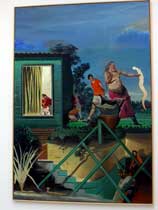
Not only is Neo Rauch a painter of huge works, loosely stroked, scumbled and dripped into shape but he’s possessed of exceptional colors in his palette (who else dips into the acid greens like this guy?). His works are Brechtian and theatrical. In Rauch’s stagey tableaux with militaristic and industrial undertones people always seem to be taking a meeting of some kind (planning an insurrection? debriefing after some action or other). Symbols abound. There’s one recurring figure who is a half-man half-animal hybrid whose sole purpose seems to be stirring up some trouble. (see image right) People often wear uniforms of no apparent country or time. Some of the uniforms are colonial era and in one particularly wintry work the ambiance was George Washington at Valley Forge — although Candyland is suggested as well in the pink and blue objects that look like game tokens on the sled. (image below)
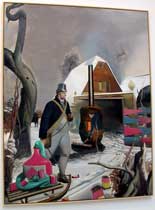
Everywhere, what’s implied by the overlapping chaos of imagery; the strident colors; and the breathless, drippy paint execution is a world at war and cabals on many sides working with or against each other. Parodies of the exhortative works of Socialist Realism and WPA-era murals, Rauch’s pieces are anti-governmental populist paintings.
Rauch’s mural-sized works implicate the viewer by enfolding you in their world. It’s impossible to view them without seeing other viewers standing in front of them. You are the audience and the witness. With the hodge podge of eras and locales depicted and with bodies distorted (small heads, huge torsos) and often floating free of the depicted space, the world’s a dream and you are a dreamer as well.
Reams of art criticism have been written about this artist. He’s worth the ink. Read another artblog post about Rauch here.
New York out-takes
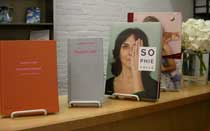
I’ll end with a few images and comments on shows Libby talked about. Sophie Calle‘s installation “Exquisite Pain” at Paula Cooper (up til June 25) seemed like an exploded book to me. And indeed, there is a book. In fact on the gallery’s front desk there are several Calle books. When I leafed through “Exquisite Pain” in book form the material made a lot better sense than the big, river-like flow of photos and material on shelves and walls connecting every space in the gallery. The whole thing, a story of the break-up of a relationship reflected on in anger in the aftermath is better in book form. And since the artist already made a full-length movie about the same issue (the break up of a different relationship), the whole thing was a little less than fresh. (image is lineup of Calle’s books on the gallery desk)
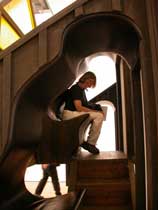
The sculpture exhibit at James Cohan was like a good museum exhibit. Maybe better since it was small in numbers of objects but large in impact. While the gallery’s write-up on Vito Acconci’s “Houses up the Wall” mentioned the fetal position in which a body curled when sitting inside the piece, I thought that what was evoked as well was a kind of dark-wood confessional, a temporary space for two people in which sins are confessed and guilt is expiated. I thought making the house a confession box mimicked the way it is in a relationship which often involves a dance of “I’m sorry” and “You’re forgiven.” (image is Ava gamely putting her body into one of the two seats in Acconci’s “Houses.”)




